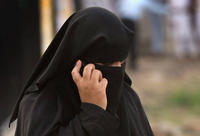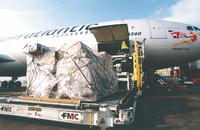-
Canadians outraged: Veiled Muslim women not required to lift veil, prove ID at airports

Canadian airport security personnel do not ask veiled Muslims women to lift their veils, show and ID, and prove their identity; the veiled women do not even interact with security personnel: rather, a man traveling with the women typically hands in all the passports and is the only one to communicate with airline staff while the veiled women simply walk through, unchecked and unidentified; a video showing two veiled women walking unchecked through security at Montreal’s Trudeau International Airport causes outrage in Canada
-
-
New explosives detection technologies show promise
An adversary who is willing to die trying to carry out a mission is one of the reasons why more conventional security organizations find it so difficult to pursue their protection mission effectively in an asymmetrical war — the kind of war terrorists engage in; new explosive detection technologies may be of help
-
-
Radiation concerns dog full-body scanners
By the end of 2014, TSA will install between 1,950 and 2,200 full-body scanners at checkpoints in all 450 commercial airports in the United States; TSA buys scanners which use two technologies — backscatter X-ray and millimeter wave; since backscatter technology raises persistent worries about radiation, some want to know why TSA should not buy only millimeter-wave scanners
-
-
DHS launches "If You See Something, Say Something" campaign for general aviation
DHS describes the campaign as a simple and effective program to raise public awareness of indicators of terrorism, crime, and other threats and emphasize the importance of reporting suspicious activity to the proper transportation and law enforcement authorities; DHS also announces new streamlined process for vetting international general aviation travel
-
-
The revival of CLEAR's Registered Traveler program
In 2003, Steven Brill, founder of Court TV and American Lawyer magazine, founded Verified Identity Pass and used it to launch the CLEAR program at Orlando International Airport; the program made it possible for pre-registered travelers to skip security checks at airports; the initial 8,000 travelers enrolled in 2003, and the service would grow to nearly 260,000 paying customers in a matter of five years; CLEAR went belly up in 2009, and its assets were bought by Algood Holdings, which relaunched the program; “Same brand, same logo, different company,” says CEO Caryn Seidman Becker
-
-
TSA wants more bomb-sniffing dogs to protect air, ground travelers
The Transportation Security Administration (TSA) wants to increase the role dogs play in sniffing out terror threats at U.S. airports and other mass transit systems; TSA requested $71 million from Congress to train and deploy 275 explosives detection canine teams — bomb dogs and their handlers — at transportation facilities
-
-
Airports, carriers face additional costs as a result of 100 percent cargo inspections
On 1 August, 100 percent of air cargo carried on passenger planes in the United States must be screened for explosives and other illicit materials before the cargo is placed on the plane; this is up from the current level of 75 percent; DHS has already said it would not meet this deadline, but carriers are worried about the added cost nonetheless: electronic screening equipment is expensive, with some units costing as much as several hundred thousand dollars
-
-
Breakthrough: day of terahertz remote sensing nears
Terahertz (THz) wave technology, has great potential for homeland security and military uses because it can “see through” clothing and packaging materials and can identify immediately the unique THz “fingerprints” of any hidden materials; a major breakthrough opens the way for detecting hidden explosives, chemical, biological agents, and illegal drugs from a distance of twenty meters
-
-
TSA will miss 1 August air cargo screening deadline

TSA will miss the congressionally mandated 1 August deadline of having 100 percent of cargo carried on planes screened; all cargo loaded onto passenger planes departing from domestic airports will be checked for explosives by the deadline, but screening all international cargo entering the United States has proved more challenging; the reason: an estimated 2.8 billion pounds of air cargo arrives in the United States every year on passenger aircraft from 94 different countries; the cargo is handled in the global air cargo supply chain by a vast number of participants; each of these 94 countries has unique air cargo security programs and regulatory requirements, many of which differ significantly from those required by TSA
-
-
The number of incidents of lasers being flashed into aircraft rises sharply; federal, state prosecutors respond
The number of incidents of lasers being flashed into aircraft has risen steadily in the past five years — from 283 cases reported to the FAA nationwide in 2005 to 1,476 incidents last year; studies have supported pilots’ reports that bright external lights can cause a flare in the goggles pilots wear, temporarily impairing sight; a laser beam hitting the eyes of a pilot who does not wear goggles may cause temporarily blindness and disorientation; as ever-cheaper lasers have made their way into ever-more hands, federal and local prosecutors have picked up the pace of criminal cases; in many cases, the prosecution uses the Patriot Act, which include a provision about deliberately interfering with the pilot of an airplane or “mass transportation vehicle” with reckless disregard for human safety
-
-
Defending U.S. civilian aircraft against shoulder-fired missile may cost $43 billion
Equipping U.S. passenger aircraft with defenses against shoulder-fired missiles may cost $43.3 billion over twenty years, DHS says in an unpublished report; airlines say the expense exceeds the risk, and oppose installing the systems — or, if such installation is made mandatory, than the government should pay for it
-
-
Scientists: Full-body scanners' radiation underestimated, could pose cancer risk
More and more scientists express their unease with the amount of radiation to which passengers are exposed as they are screened by full-body scanners at airports; experts say radiation from the scanners has been underestimated and could be particularly risky for children; they say that the low level beam does deliver a small dose of radiation to the body, but because the beam concentrates on the skin — one of the most radiation-sensitive organs of the human body — that dose may be up to 20 times higher than first estimated
-
-
Airport security is big business, and Rapiscan Systems benefits
Airport security is serious business and, increasingly, it is also big business; TSA plans to deploy as many as 1,800 full-body scanner at U.S. airports by the end of 2014; at $170,000 a scanner, this is a $300 million proposition
-
-
Schumer pushing for new airport security scanning device
New York senator claims new scanner, produced by a Long Island-based company, would have prevented Shahzad from getting past no-fly list; the new scanning device would cross check passengers, weed-out fake IDs, and track visa overstays
-
-
6-year-old Ohio girl on DHS's terror watch list
A 6-year old Ohio girl made to go through secondary screening at Cleveland airport before being allowed on board because her name was on TSA’s terror watch list; the family contacted DHS, and the 6-year old received a letter from the department which would neither confirm nor deny any information they have about her
-
More headlines
The long view
New Technology is Keeping the Skies Safe
DHS S&T Baggage, Cargo, and People Screening (BCP) Program develops state-of-the-art screening solutions to help secure airspace, communities, and borders
